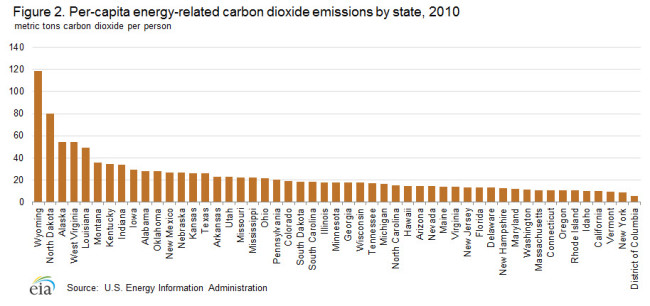
Pennsylvania Power’s Colstrip Power Plant
By Derf Johnson
Last week brought some terrible news for those of us in Montana that care about reducing global warming emissions and stabilizing our climate. The U.S. Energy Information Administration (EIA) reports that Montana’s energy related C02 emissions rate increased from 2000-2010 by 11.4%. Rather than recognizing and making efforts to address the very serious problem with continuing to emit heat-trapping gases, Montana has increased the amount of emissions that we spill out into our Big Sky every single year. In 2010 alone, Montana emitted over 34.9 million metric tons of C02 emissions.
Montana ranks low (41st) in the total emissions we released, when compared to other states. But when you look at the emissions that each individual was responsible for, per capita emissions, Montana moved up to 6th in the nation, only lagging behind Wyoming, North Dakota, Alaska, West Virginia, and Louisiana. The common theme being that all of these states are relatively rural, fossil fuel energy producing states. But the reason for Montana’s incredibly high ranking deserves some serious extra scrutiny (details on this later).
Barely a Blip on the Media’s Radar
What’s almost as disturbing as these dreadful numbers is the virtual lack of coverage in our major media outlets here in Montana. The Associated Press managed to muster up a story that amounted to a heartless 124 words, barely more text than a cheap ad in a weekly and certainly not comprehensive coverage on the most pressing issue facing humanity – the cooking of our planet.
All the while, the press manages to publish a story the same day (totaling 176 words) on a record-breaking 96-degree May 13th in Billings. Completely lacking from the Gazette’s reporting on Billings ridiculous heat spike is any mention of climate change as a possible driving factor, that we have recorded the 337th consecutive month above the 20th century global temperature average, that C02 emissions from Montana are contributing to the problem, and that the world is near or has surpassed 400 ppm of C02 concentrations in our atmosphere (a feat that shouldn’t go unnoticed, as the last time concentrations of carbon were this high in our atmosphere was 3 million years ago).
Digging in to the Numbers
How did Montana, a state with a low population, rank 6th in per-capita C02 emissions? The answer largely lies in what the EIA terms “The Net Electricity Trade Index” (NETI). The NETI looks at whether a state is “self sufficient in the generation of electricity in a given year (a value of 1.0); is a net importer of electricity in a given year (a value of less than 1.0); or is a net exporter of electricity in a given year (a value greater than 1.0).” Most recently (in 2010), Montana hit a 2.0 NETI, presumably meaning that we export as much of the fossil fuel energy we produce in Montana as we use within the state.
But how EIA calculates carbon dioxide emissions is by analyzing “emissions released at the location where fossil fuels are used.” This means that the vast majority of the fossil fuels that we produce (which are shipped out of state and burned elsewhere) are not calculated into our total emissions. We export the vast majority of the oil and gas we produce, and a huge portion of the coal we mine every year goes out of state, so what gives?
To nail down the problem as to why per capita Montana global warming emissions are so high we have to look at the 17.1 million metric ton gorilla in the room that is driving a disproportionate share of Montana’s C02 emissions – the Colstrip coal-fired power plant. Colstrip is Montana’s largest electricity generating facility (by leaps and bounds), with a capacity of generating over 2,094 megawatts of coal-fired power. Colstrip is also responsible for a serious volume of C02 emissions – according to the Environmental Protection Agency’s greenhouse gas inventory program Colstrip sent out over 17,120,416 metric tons of C02 in 2010 alone.
In a “back-of-the-envelope” calculation, if we were to remove Colstrip from our C02 equation, our 2010 total emissions would be reduced by almost half (from 34.9 to 17.8 million metric tons), and our per capita ranking would move down to somewhere around 25th in the nation.
The Colstrip coal-fired plant is owned by a consortium of six utilities with different ownership percentages, and operated by Allentown, Pennsylvania based Pennsylvania Power and Light. Colstrip has four generating units that distribute power across the western United States, sending dirty coal power to metropolitan areas as far as Seattle (Puget Sound Energy) and Portland (Portland General Electric). Avista, Pacificorp, and NorthWestern Energy also own shares of the Colstrip plant.



[…] plants are the single largest source of carbon pollution in the United States, and in Montana comprise approximately half of our total energy related carbon pollution emissions. Needless to say, tackling pollution from power plants is the single largest step that the United […]